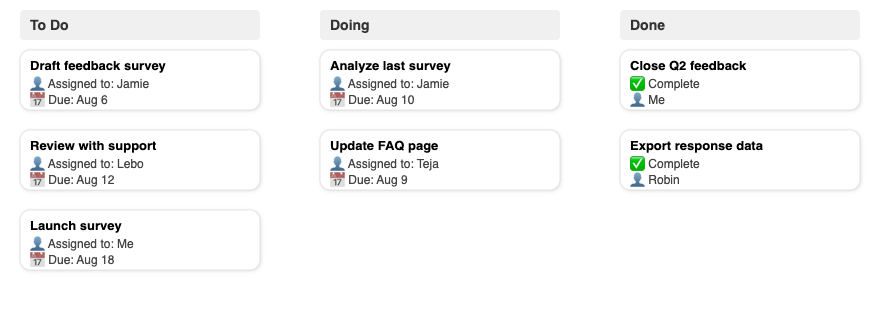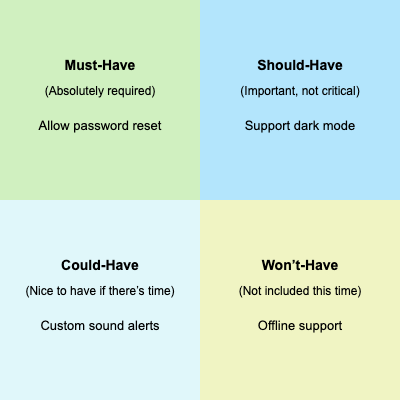A clear plan is the foundation of every successful project. Just like building a house starts with a solid blueprint, breaking down big ideas into actionable steps, setting realistic expectations, and prioritizing what matters most sets your team up for smooth progress and real results.
This lesson will show you how to:
- Turn stakeholder needs into clear, actionable plans so everyone has well-defined responsibilities and a shared roadmap.
- Break down work and estimate effort realistically to avoid overwhelming the team.
- Prioritize tasks using the MoSCoW framework to distinguish between must-haves, should-haves, and nice-to-haves when planning project scope.
Clarity is your best friend when planning a project. Replace vague goals with specific tasks, assigned owners, and clear deadlines. This way, everyone knows what’s expected and when.
For example, rather than “Improve customer feedback process,” break it down into steps like:
- “Draft new feedback survey” (Jamie, due August 6)
- “Review survey with support team” (Lebo, due August 12)
- “Launch survey to customers” (Me, due August 18)
Shared project management boards, like Asana or Jira, help everyone stay on the same page. When each step is clearly defined, assigned, and updated in a shared space, it’s easy for everyone to see their tasks and track progress. This visibility boosts accountability and keeps the project moving forward. Here’s a visual example of how the tasks above might look on a project management board:

Scoping means understanding the size and complexity of each task. Start by breaking big tasks into smaller, manageable pieces. For each one, estimate how much time and what skills are needed. In many teams, estimation techniques like story points are used. These assign a number to each task based on its complexity and the time it might take, helping teams compare and prioritize work more effectively.
For example:
- “Drafting a survey” might take 2 hours and be estimated at 1 story point.
- “Analyzing 200 responses” could take a full day and be estimated at 3 story points.
Story points are a way to quickly compare the effort and complexity of different tasks, rather than relying only on exact hours. If you’re unsure, add a little buffer to your estimates to avoid surprises. It’s also important to be realistic about your team’s capacity. For instance:
“Testing the new feature is estimated at 3 story points and will take about 3 days, but QA is only available for 2 days this week, so we’ll need to adjust the timeline or get extra help.”
Think of it like building a house: if your electrician is already working on another project, you can’t schedule wiring before they’re available. Planning with everyone’s workload in mind helps you avoid delays, bottlenecks, and missed deadlines.
A common saying in the corporate world is, “everything should’ve been done yesterday.” But since that’s not realistic, you’ll need to prioritize. The MoSCoW framework helps you and your stakeholders agree on what’s essential and what can wait. Here’s how it works:

When new requests come in, you can say:
“That’s a great idea, but based on our priorities, it’s a Could-Have for now. Let’s revisit it after launch.”
This keeps everyone focused and helps protect your timeline.
Here’s how this looks in a real conversation:
- Jessica: Chris, I noticed you added three new features to the project list. Can we review them together?
- Chris: Absolutely. I think they’d really improve the user experience, but I’m not sure how they fit with our current timeline.
- Jessica: Let’s use the MoSCoW framework. For example, “The app must allow users to reset their password” is a Must-Have, but “custom notification sounds” might be a Could-Have. What do you think?
- Chris: That makes sense. The password reset is critical, but the notification sounds can wait if we’re tight on time.
- Jessica: Great. I’ll update the plan so we focus on the essentials first, and we can revisit the Could-Haves after launch.
Jessica uses the MoSCoW framework to clarify priorities, set expectations, and keep the project on track. She invites Chris’s input and uses specific examples to guide the conversation.
By practicing clear planning, realistic scoping, and thoughtful prioritization, you’ll lead projects that deliver real value without the chaos. Up next, you’ll get to apply these skills in a realistic writing task where you’ll break down a project and prioritize its features.
